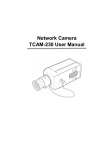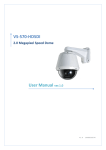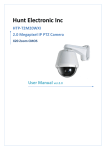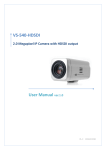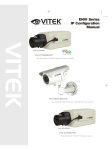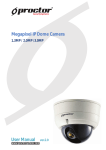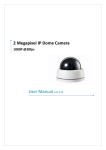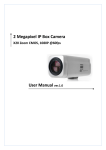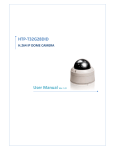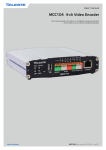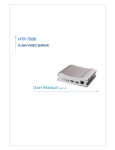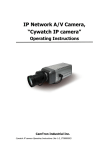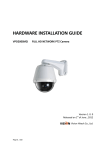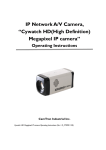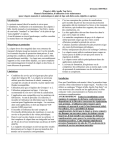Download User Manual ver.1.0 HTP-T2M1000ISWB
Transcript
HTP-T2M1000ISWB 2.0 Megapixel Speed Dome User Manual ver.1.0 HTP-T2M1000ISWB User Manual Safety Precaution We appreciate your purchasing HTP-T2M1000ISWB. Before installing the product, please read the following with care. Make sure to turn off the power before installing HTP-T2M1000ISWB. Do not install under the direct sunlight or in dusty areas. Make sure to use the product within the temperature and humidity specified in the specification. Do not operate the product in presence of vibrations or strong magnetic fields. Do not put electrically conducting materials in the ventilation hole. Do not open the top cover of the product. It may cause a failure or electric shock on the components. To prevent from overheating, make sure to keep the distance at least 10cm from the ventilation hole. Make sure proper voltage (220V/100V) before connecting the power. 2.0 Megapixel Speed Dome Manual 2/54 HTP-T2M1000ISWB User Manual Table of Content 1. Introduction ................................................................................................................................. 4 About this manual ..................................................................................................................... 4 Features ................................................................................................................................... 4 Product and Accessories .......................................................................................................... 7 Part Names and Functions ....................................................................................................... 8 System Connections................................................................................................................. 9 2. Installation ................................................................................................................................. 12 DIP Switch Setup.................................................................................................................... 12 Installation Camera with Brackets ........................................................................................... 14 Wiring/Cabling & Connecting .................................................................................................. 16 Check if it works ..................................................................................................................... 19 3. System Operation ..................................................................................................................... 20 Remote Video Monitoring ....................................................................................................... 20 Initialization of IP address ....................................................................................................... 23 4. Remote Configuration ............................................................................................................... 24 Using Web Brower.................................................................................................................. 24 System Configuration ............................................................................................................. 25 Video Configuration ................................................................................................................ 29 Audio Configuration ................................................................................................................ 34 Network Configuration ............................................................................................................ 35 Serial Configuration ................................................................................................................ 40 Event Configuration ................................................................................................................ 42 PTZ Configuration .................................................................................................................. 45 Record Configuration.............................................................................................................. 49 User Configuration.................................................................................................................. 50 Camera Configuration ............................................................................................................ 52 2.0 Megapixel Speed Dome Manual 3/54 HTP-T2M1000ISWB User Manual 1. Introduction About this manual This User Manual provides information on operating and managing the premium network camera, HTPT2M1000ISWB. The Manual includes instructions of installation, operation and configuration of HTPT2M1000ISWB as well as how to make troubleshooting. Features HTP-T2M1000ISWB is a 2.0M PTZ network-based camera with remote live monitoring, audio monitoring and control via an IP network such as LAN, ADSL/VDSL, and Wireless LAN. Camera • 1/3” 2Megapixel CMOS Image Sensor • X10 optical zoom, x12 digital zoom • True Day & Night (ICR) Video • Highly efficient compression algorithm, H.264 & MJPEG support • 18 kinds of compression and resolutions: CIF (352x240) - Full HD (1920x1080) • Wide range of transmission rates: 32kbps ~ 8Mbps • Various transmission modes: CBR, VBR • Motion detection • Composite video output • HD-SDI video output (Option) • Multi-transmission mode: Simplex (HTP-T2M1000ISWB Client PC or Decoder, Client PC or Decoder HTP-T2M1000ISWB), Full Duplex Audio Network • Fixed IP & Dynamic IP (DHCP) support • 1:1, 1:N support • Multicasting • Various types of Protocol support : TCP/IP, UDP, Multicast, DHCP, SMTP, HTTP, SNMP, RTP, RTSP 2.0 Megapixel Speed Dome Manual 4/54 HTP-T2M1000ISWB User Manual Serial Data • RS-485 support • Data pass-through mode : Serial data communication between HTP-T2M1000ISWB and Decoder Sensor and Alarm • Support direct connections of external sensor and alarm devices • Event Alarm notification. • 2 alarm sensor Inputs and 2 alarm Output relays are available • If an external sensor is activated, camera can be set to move to the corresponding Preset position. User Interface • Diagnose and upgrade through dedicated program called True Manager • System configuration using Internet Explorer High Reliability • Reliable embedded system Powerful Pan/Tilt Functions • Max. 360/sec high speed Pan/Tilt Motion • Using Vector Drive Technology, Pan/Tilt motions are accomplished in a shortest path. As a result, time to target view is reduced dramatically and the video on the monitor is very natural to watch. • For jog operation using a controller, since ultra slow speed 0.05/sec can be reached, it is very easy to locate camera to desired target view. Additionally it is easy to move camera to a desired position with zoom-proportional pan/tilt movement. Preset, Pattern, Swing, Group • MAX. 128 Presets are assignable and characteristics of each preset can be set up independently, • Max. 8 set of Swing action can be stored. This enables to move camera repetitively between two preset positions with designated speed. • Max. 4 of Patterns can be recorded and played back. This enables to move camera to follow any trajectory operated by joystick as closely as possible. • Max. 8 set of Group action can be stored. This enables to move camera repetitively with combination of Preset or Pattern or Swing. A Group is composed of max. 20 entities of Preset/Pattern/Swings. 2.0 Megapixel Speed Dome Manual 5/54 HTP-T2M1000ISWB User Manual PTZ(Pan/Tilt/Zoom) Control • With RS-485 communication, max. 255 of cameras can be controlled at the same time. • Pelco-D or Pelco-P protocol can be selected as a control protocol in the current version of firmware.. Easy Installation and Perfect Outdoor Environment Compatibility • Fans and heaters are built-in in camera for cold and hot temperature environment. Also idealistic mechanical design protects camera from water and dust. (IP 67) • It is easy to install and maintain camera with terminal for cable connection in brackets. 2.0 Megapixel Speed Dome Manual 6/54 HTP-T2M1000ISWB User Manual Product and Accessories Main body & Dome Cover Accessories Main Cable Cross LAN Cable Wrench Driver 2EA of BNC Audio Cable CD Note: Mount Brackets are optional. Wall Mount Bracket [Screws : Torx Secrew M418, Hex Lag #1450] 2.0 Megapixel Speed Dome Manual Ceiling Mount Bracket [Screws : Torx Screw M418, Anchor Bolt 3/8"70] 7/54 HTP-T2M1000ISWB User Manual Part Names and Functions ① • Dome Cover Do not detach protection vinyl from dome cover before finishing all installation process to protect dome cover from scratches or dust. • DIP Switch Sets up camera ID and protocol. • Drop Prevention Spring This part keeps the camera from dropping during installation and maintenance. After install the Bracket, please, hang the spring to the drop prevention hook of main body as shown in picture for further tasks. • Mounting Screw Hole This hole is for screws that assembles the main body with a bracket. • IP Reset Switch Reset its network configuration to the factory defaults. You will lose all data that had been entered previously. To initialize the system to the factory default, press the reset button for more than 5 seconds. • LAN Port Used for the Ethernet connection • Audio Port Used for the audio in/out connection. • Video (BNC) Used for the composite video out or HD-SDI video out connection according to models • Main Connector Used for the power wire, the RS-485 communication cable, alarm in/out connection cable. 2.0 Megapixel Speed Dome Manual 8/54 HTP-T2M1000ISWB User Manual System Connections HTP-T2M1000ISWB IP Cameras can be connected in either 1 to 1 connection where one HTPT2M1000ISWB is connected to one PC client or a decoder system or 1 to many connections where one HTP-T2M1000ISWB can be connected to several PCs and decoder systems. (TCS-2000 video server can work as a video decoder which takes the data from a video server or IP camera, decodes and outputs analog video.) Topology Generally, HTP-T2M1000ISWB and PC or a decoder is connected in 1-to-1 mode or 1-to many configuration. 1:1 Connection . Site Site Remote Center (Decoder) Remote Center Remote Center (PC SW) One HTP-T2M1000ISWB is installed at a site where video images are transmitted. A PC or a decoder is installed at a central location to receive and view the video images on an analog monitor. Audio and serial data are transferred in either direction. 2.0 Megapixel Speed Dome Manual 9/54 HTP-T2M1000ISWB User Manual 1:N Connection . Site Remote Center or or or In this configuration, a site can be monitored from many remote central locations. Although up to 64 PCs or decoders can be connected to one HTP-T2M1000ISWB, in the real network environment, network bandwidth can limit the maximum connections. Functionally, the central monitoring system (CMS) software provided can replace the decoder. Multicast Mode If the network supports multicasting, a large number of decoders can be used to receive video effectively from a HTP-T2M1000ISWB using a single streaming of video and audio. However, multicast mode is possible only when network environment supports multicast. Relay Site Center 1(Decoder) Center 2 (Decoder) Video and audio data can be retransmitted from a center to another center. The arrangement is useful when the network bandwidth to the site is limited while there are more than one center want to monitor the site. 2.0 Megapixel Speed Dome Manual 10/54 HTP-T2M1000ISWB User Manual CMS (Central Monitoring System) Site Site Remote Center Remote Center (Decoder) CMS CMS (Central Monitoring System) is a Window-based remote monitoring program in order to monitor or control video, audio, and events in real time from several IP cameras or video servers. Please refer to the CMS User Manual for more in detail. 2.0 Megapixel Speed Dome Manual 11/54 HTP-T2M1000ISWB User Manual 2. Installation DIP Switch Setup When you control the camera through RS-485, before installation, you should set the DIP switches to configure the camera ID, communication protocol. Camera ID setup ON ON ID numbers of camera are set up with binary numbers.. See the examples shown below 1 2 3 4 5 6 7 8 2.0 Megapixel Speed Dome Manual Pin 1 2 3 4 5 6 7 8 ID Value 1 2 4 8 16 32 64 128 ex) ID=5 on off On off off off off off ex) ID=10 off on Off on off off off off The camera ID range is 1~255. Camera ID must not be 0. Factory default of Camera ID is 1. Match the camera ID with Cam ID setting of your DVR or Controller to control the camera. 12/54 HTP-T2M1000ISWB User Manual Communication Protocol Setup ON ON 1 Select the appropriate Protocol with DIP switch combination. Switch State 2 3 4 P0 (Pin 1) P1 (Pin 2) P2 (Pin 3) Protocol/Baud rate OFF OFF OFF PELCO-D, 2400 bps ON OFF OFF PELCO-D, 9600 bps OFF ON OFF PELCO-P, 4800 bps ON ON OFF PELCO-P, 9600 bps Otherwise Reserved If you want to control using DVR or P/T controller, their protocol must be identical to camera. Otherwise, you can not control the camera. 2.0 Megapixel Speed Dome Manual Adjust the DIP switch after turning off the camera. If you changed the camera protocol by changing the DIP switch, the change will be effective afterh you reboot the camera. Factory default of protocol is “Pelco-D, 2400 bps”. 13/54 HTP-T2M1000ISWB User Manual Installation Camera with Brackets Installation using Ceiling Mount Bracket ① Remove the ceiling tile from the ceiling and cut a hole whose diameter is 30~40mm on the ceiling tile to pass the wire(s) and cable(s) through to the upside of the ceiling. (In case of the wiring and cabling through the mounting surface only) Then prepare the ceiling mount bracket. Pull the wire(s) for the system as below. (Anchor Bolt 3/8"×70) ② Hook up “Drop Prevention Spring” on main body ③ Line up the mold lines and assemble main body to mount adaptor and turn it. And assemble the main both with the camera mount adaptor with the screws. (Torx screw M4X18). Please make sure the screws are tightly assembled for waterproof. ④ Screw the dome cover to the main body and remove the protection vinyl from the dome cover. to prevent camera from unexpected drop and pull the wire(s) and cable(s) for the system as below Notice Before starting the installation, make sure that the Camera ID and Protocol are set up properly. To adjust the installation height from the mounting surface, the pipe and coupler should be needed between the surface mount part of the ceiling mount bracket and the camera mount part of the ceiling mount bracket. Note that they are not supplied by the manufacturer. 2.0 Megapixel Speed Dome Manual 14/54 HTP-T2M1000ISWB User Manual Installation using Wall Mount Bracket ① Make a hole whose diameter is 30~40mm on the mounting surface to pass the wire(s) and cable(s) through the mounting surface. (In case of the wiring and cabling through the mounting surface only) Then prepare the wall mount bracket. Pull the wire(s) and cable(s) for the system as below. Attach the wall mount bracket to the mounting surface. (Hex Lag #14×50) ② Hook up “Drop Prevention Spring” on main body to ③ Line up the mold lines and assemble main body to prevent camera from unexpected drop and pull the wire(s) and cable(s) for the system as below. ④ Screw the dome cover to the main body and mount adaptor and turn it. And assemble the main remove the protection vinyl from the dome both with the camera mount adaptor with the screws. cover. (Torx screw M4X18). Please make sure the screws are tightly assembled for waterproof. Notice Before starting the installation, make sure that the Camera ID and Protocol are set up properly. 2.0 Megapixel Speed Dome Manual 15/54 HTP-T2M1000ISWB User Manual Wiring/Cabling & Connecting Port Description Main Cable Port Pin Number (RJ45) Connector / Wire Color Signal 1 Black RS485 + 2 Brown RS485 3 Red DC 12V 4 Orange Ground 5 Yellow OUT COM (Relay Output Common) 6 Green OUT 2 (Relay Output 2) 7 Blue OUT 1 (Relay Output 1) 8 Violet IN COM (Sensor Input Common) 9 Gray IN 1 (Sensor Input 1) 10 White IN 2 (Sensor Input 2) Port Pin Number Connector/ Wire Color Signal 1 RCA (Yellow) Audio IN Audio Cable 2 3 2.0 Megapixel Speed Dome Manual Audio GND RCA (White) Audio OUT 16/54 HTP-T2M1000ISWB User Manual Connecting Power 1. Carefully check the voltage and current capacity of the rated power. The rated power is indicated in the back of main unit. 2. After confirming the power source, connect power adaptor and connect the 12V DC connector to the system For the DC input models, be careful with the polarity of DC power. The system should be permanently damaged by wrong DC input. In case that the length of the power wire is very long, there may be voltage drop and the system may not work properly. Make the length of the power wire as short as possible. Connecting Network 1. Plug network cable to Ethernet port (RJ-45 network port). Connecting Video 1. To display video through the composite or HD-SDI port, connect each port to a monitor using BNC coaxial cable 2. Set Enable Preview option “ON” on the Video tab of web page. (Please refer to the Video Configuration part) Especially in case of using HD-SDI, video cannot be viewed if BNC coaxial cable is not used. In case that video transmission distance is long, video data may not be transmitted due to a reduction in the video signal. In order to prevent it, install a repeater in the middle. In case of using HD-SDI, video can be viewed only on a HD-SDI monitor. Connecting Audio Audio is full-duplex. It is possible to set the mode as Tx-only, Rx-only or Tx-Rx. 1. Connect audio input and output ports to audio devices accordingly. 2. The Audio signal required is line level, so an audio equipment with an amp, mixer or other amplifier should be used. 2.0 Megapixel Speed Dome Manual 17/54 HTP-T2M1000ISWB User Manual Connecting Serial Port (RS-485 Communication) For PTZ control, connect the cable(s) to your keyboard or DVR. To connect multiple cameras to a single controller, RS-485 communication should be connected in parallel as shown below. If you are connecting a single camera to a controller, terminate the camera. When connecting more than one camera to a single controller, terminate the last camera on the communication line. The last camera means the camera farthest in cable length from the controller. Note that the total length of the communication cable between a controller and the camera(s) on the same communication line must be less than 1.2Km. RS-485 of HTP-T2M1000ISWB can be connected to external equipment such as PT receiver etc. PC client can send PT commands to the external equipment via the serial port. When a decoder system instead of PC client is connected to HTP-T2M1000ISWB, the serial port and that of the decoder system works in pass-through mode. That is, data from at one port is delivered to the other port, vice versa Connecting Sensor and Alarm Connect sensor and alarm devices to corresponding terminals accordingly. Sensor Input 2.0 Megapixel Speed Dome Manual 18/54 HTP-T2M1000ISWB User Manual Relay Output Internal AC or DC OUT COM OUT 1 LOAD OUT 2 LOAD Maximum allowable electrical load of relay is shown bellow table. Drive Power DC Power AC Power Max. Load Max DC 24V, 1A Max AC 125V, 0.5A Check if it works Once the power is supplied to the camera, it will start booting. The system will boot up to an operating mode after approximately 40-60 seconds. The green LED on the Ethernet port will flash indicating the system is ready. The software provided in the CD called True Manager allows you to check the IP address and other network details of the camera. Please refer to the True Manager manual for instructions on how to find the IP address of the camera and change it if required. 2.0 Megapixel Speed Dome Manual 19/54 HTP-T2M1000ISWB User Manual 3. System Operation Remote Video Monitoring There are two ways to monitor video when the center system and HTP-T2M1000ISWB are connected. In order for a proper operation, an IP address must be set accordingly. Please refer to True Manager in Chapter 3 or Remote Setting in Chapter 4 for further details. Default ID : admin Default Password : 1234 . Video Monitoring using Internet Explorer Open Internet Explorer and enter HTP-T2M1000ISWB‟s IP address. The system will ask for confirmation to install Active-X control. Once authorized, the Internet Explorer will start to display video images from HTPT2M1000ISWB as shown below. Default IP Address : http://192.168.10.100 2.0 Megapixel Speed Dome Manual 20/54 HTP-T2M1000ISWB User Manual Video Selection Select the Video stream to be viewed: Primary or Secondary HTP-T2M1000ISWB is capable of dual streaming; primary streaming and secondary streaming. Video will be displayed according to the resolution set on video configuration. If dual streaming (“Use Dual Encode” Menu in Video page) is not activated, secondary video is not available Screen Size Adjust the Screen size Screen size is initially adjusted according to the compression resolution. If you click x1/2 icon, the whole screen size will be reduced in a half. Digital Zoom Control the Digital zoom on the screen The more the camera zooms in, the smaller the square of control panel is. Position of the image can be changed by moving position of the square. Max x5 Digital Zoom is available. If you press x1, the screen will return to the normal size. PTZ Control Panel (Optical Zoom & Digital zoom built-in the camera) Control PTZ and PTZ Control Panel is used for controlling external PTZ devices when the external PTZ devices are connected through serial port. Since x10 optical zoom and x12 digital zoom lens is built in HTPT2M1000ISWB, it is possible to make zooming control by Zoom in/out buttons of PTZ control Panel (In order to use digital zoom, select Digital zoom ON in the Camera tab) Focus Near, Focus Far, Auto Focus Adjust the focus of the lens Menu On, Enter, ESC Display and control OSD(On Screen Display) menu if OSD menu is supported. (HTP-T2M1000ISWB does not support OSD menu) - Menu On: Display OSD menu list - Enter: Select or operate menu items - ESC: Cancel or go back to the previous menu 2.0 Megapixel Speed Dome Manual 21/54 HTP-T2M1000ISWB User Manual Select Preset Set preset position and move to the specific preset position. - Go to: Move to the selected preset entry if the preset entry is set. - Set: Set the current position to the selected preset entry. - Clear: Delete the selected preset entry. Select List Operate the selected Pattern or Swing or Group. (Please refer to the PTZ tab to set Pattern, Swing and Group) Sensor Input Display the status of the sensor in real time. HTP-T2M1000ISWB supports two sensor inputs. When the sensor of HTP-T2M1000ISWB is working, the sensor light turns red. Alarm Output Operate the alarm device by pressing the number icon HTP-T2M1000ISWB supports two alarm outputs. A number icon indicates status of the alarm device. Screen Capture Capture video images and store them as BMP or JPEG files. Audio Transfer Transfer audio from a PC that displays video image currently to HTP-T2M1000ISWB. File record Recording to an AVI file on Live view page is available. AVI files are generated in the specified folder or in specified file name on the PC where web browser is running. 1. Enter the drive and the folder name on the PC and enter the AVI file name to be used. 2. Press “Start” button to start to record. 3. Press “Stop” button to stop to record. 4. AVI file named “File name_IP address_hh_mm_ss” will be generated in the specified folder. 2.0 Megapixel Speed Dome Manual 22/54 HTP-T2M1000ISWB User Manual Video Monitoring with Decoder System Once HTP-T2M1000ISWB‟s IP address is set in the remote IP address section of the decoder, the decoder system will connect to HTP-T2M1000ISWB and start receiving the video images. Normally, a monitor connected to the decoder will display video images Initialization of IP address If a system IP address is lost, the system can be reset to the system default IP address using the reset button in the back side of the system. 1. While system is in operation, press the reset button for more than 5 seconds. 2. The system will reboot automatically 3. Once the system reboots, IP address will be set to the system default as below. IP mode Fixed IP IP address 192.168.10.100 Subnet mask 255.255.255.0 Gateway 192.168.10.1 Base port 2222 HTTP port 80 2.0 Megapixel Speed Dome Manual 23/54 HTP-T2M1000ISWB User Manual 4. Remote Configuration Using Web Brower Remote setting is available by using web browser. Enter IP address of HTP-T2M1000ISWB and then a live view screen appears as below. Press Setup button located in the upper right area of the monitoring screen to go to the server setup. For Remote Setting, user should be authorized higher than manager level. Enter IP Address Press Setup button The configurations are grouped into 10 categories: System, Video, Audio, Network, Serial, Event, PTZ, Record, User and Camera. Any configuration changes are not applied until Apply button is pressed. Leaving the page without pressing Apply button, any changes in the page will be discarded. 2.0 Megapixel Speed Dome Manual 24/54 HTP-T2M1000ISWB User Manual System Configuration 2.0 Megapixel Speed Dome Manual 25/54 HTP-T2M1000ISWB User Manual General System ID Enter System ID that is used as a camera title The set System ID is displayed with video image on Web browser. The System ID is also transferred to remote software, such as CMS, and displayed on it. Language Select the language to be used for web-based configuration Firmware Firmware version Display the current firmware version Board ID Display the Network board ID of HTP-T2M1000ISWB recognized by system Upgrade Upgrade firmware 1. Press Browse button to select a firmware file from PC. 2. Press Firmware Upgrade button to start to upgrade. 3. Messages for showing status (downloading / upgrading) will be displayed. 4. The camera will reboot automatically after completing upgrade. Do not turn the camera off during upgrading 2.0 Megapixel Speed Dome Manual 26/54 HTP-T2M1000ISWB User Manual Time Start Time Latest the camera‟s booting date and time Current Time Current date & time Enter a new date and time and press Set Current Time button to update date & time Time Format Change the time format. Selectable time formats are as below - YYYY/MM/DD hh:mm:ss (Ex. 2010- 4-11 18:18:42) - DD/MM/YYYY hh:mm:ss (Ex.11- 4-2010 18:18:42) - MM/DD/YYYY hh:mm:ss (Ex. 4-11-2010 18:18:42) Time Zone Select time zone of where the camera is installed. Depending on the time zone, Daylight Saving Time will work automatically A time zone is a region of the earth that has uniform standard time, usually referred to as the local time. By convention, time zones compute their local time as an offset from UTC (Coordinated Universal Time). In casual use, GMT (Greenwich Mean Time) can be considered equivalent to UTC. Local time is UTC plus the current time zone offset for the considered location . Automatically synchronize with NTP server Synchronize the camera time with an NTP server using NTP (network time protocol). Name of the NTP server should be registered on NTP server Name. The Network Time Protocol (NTP) is a protocol for synchronizing the clocks of computer systems over packet-switched, variable-latency data networks. It is designed particularly to resist the effects of variable latency by using a jitter buffer. Reboot Reboot the camera. Do not press the Reboot button unless the server needs a reboot. 2.0 Megapixel Speed Dome Manual 27/54 HTP-T2M1000ISWB User Manual Factory Reset Current IP Address of HTP-T2M1000ISWB is changed to default IP Address, 192.168.10.100. System log and user registrations are also cleared. The other setting value will be remained. Note that Password will not be changed by the factory reset for the security purpose. Please contact the manufacturer when you forget your password. 2.0 Megapixel Speed Dome Manual 28/54 HTP-T2M1000ISWB User Manual Video Configuration 2.0 Megapixel Speed Dome Manual 29/54 HTP-T2M1000ISWB User Manual Encode Enable Preview 1. Select ON to enable to display video on the monitor that is connected to the composite or HD-SDI video port. 2. Select the Output format accordingly in the end of the Video page. Note that when Enable Preview is ON, dual streaming is not available. When the video is transmitted directly to the monitor through BNC cable, the video does not go thorough network and encoding. Therefore, there is less delay and no an effect from network limitation. Resolution Select video encoding resolution. 18 steps of the resolution are available. Scaling option is used when encoding resolution is different from input compression. Without Scaling option, input video will be cut according to encoding resolution. On the other hand, if Scaling is selected, input video will be adjusted according to encoding resolution. Frame rate Determine the maximum number of frames per second for the video stream. 1,2,3,4,5,6,8,10,15,20,25 and 30 frame rate can be selected. The actual frame rate of video can be less than the maximum frame rate set due to the network bandwidth limitation Preference Select encoding mode to control video quality: Quality or Bit rate. If „Bit rate‟ selected, the video encoding will be effected by the „Bit rate‟ value entered. Therefore, “Bit rate” mode is CBR (Constant Bit rate) encoding. If „Quality‟ selected, the video encoding will be effected by the quality of image selected. Therefore, “Quality” mode is VBR (Variable Bit Rate) encoding. 2.0 Megapixel Speed Dome Manual 30/54 HTP-T2M1000ISWB User Manual Quality Select Video quality. 7 levels of quality are available. Quality mode (VBR encoding) adjusts the bit rate according to the image complexity, using higher bandwidth for increased activity in the video and lower bandwidth for decreased activity. It is preferred when the activity change in the video is significant or the network capacity is insufficient to allot certain bit rate continually. Bit rate Determine bit rate value between 0 ~ 8000kbps. Bit rate mode (CBR encoding) allows you to set a fixed target bit rate that consumes a predictable amount of bandwidth. If the network capacity is good enough to allot certain bit rate and substantial bit rate is set, lowering quality can be prevented regardless of the activity change in the video. I-Frame Interval Determine I-frame Interval between 0 and 255. There will be no I-frames if 0 is selected. H.264 Profile Select H.264 Profile: High Profile or Baseline Profile The standard defines various sets of capabilities, which are referred to as profiles, targeting specific classes of applications. - High Profile (HiP) The primary profile for broadcast and disc storage applications, particularly for high-definition television applications (for example, this is the profile adopted by the Blu-ray Disc storage format and the DVB HDTV broadcast service). - Baseline Profile (BP) Primarily for low-cost applications that require additional data loss robustness, this profile is used in some videoconferencing and mobile applications. This profile includes all features that are supported in the Constrained Baseline Profile, plus three additional features that can be used for loss robustness (or for other purposes such as low-delay multi-point video stream compositing). 2.0 Megapixel Speed Dome Manual 31/54 HTP-T2M1000ISWB User Manual Dual Encode Use Dual Encode 1. Select Off button on the Enable Preview to enable to use Dual Encode 2. Select ON to enable to use Dual Encoding The secondary video can be viewed on Live View window by selecting Secondary on Video selection Dual Compression Algorithm Select H.264 or MJPEG for the secondary streaming. Maximum resolution is1280 x720 and 9 steps of resolution are available. If MJPEG is selected, only “Quality” mode is supported Motion Detection Use Motion Detection Determine to use Motion Detection function Motion Detection Area Editing Configure regions for motion detection. Regions of arbitrary shape can be configured by the following steps. Select Enable on Edit tab Select editing Mode. Set is for including cells to motion detection region and Erase is for excluding. Select cells using the right button of the mouse. Multiple cells can be selected conveniently by press and dragging. Press Apply Edited Area to save the editing 2.0 Megapixel Speed Dome Manual 32/54 HTP-T2M1000ISWB User Manual Sensitivity Sensitivity is the condition to trigger an event of motion detection. The value determines the sensitivity of the motion detection within a block: the smaller, the more sensitive. It is selectable from 0 to 10. Information Display System ID and/or server time can be display over the video window in Internet Explorer. Each item can be turn on or off separately, and position also can be configure. This information is displayed after the video is decompressed Burn-in OSD Insert system ID and date/time in the compressed video. System ID and time respectively can be turned on or off in the video. And position and Font size can be selectable. Note that since time information is inserted when video is compressed, the change of the time can be considered as motion. Therefore, even though there is no motion, motion detection can be activated. In order to prevent it, exclude the area of displayed time by Motion detection area editing. Output Format Output Format menu appears only when Enable Preview is on Select the output format for the monitor preview according to the video output and monitor specification.. 2.0 Megapixel Speed Dome Manual 33/54 HTP-T2M1000ISWB User Manual Audio Configuration Algorithm Algorithm Select the audio algorithm: G.711 or AAC Bit rate Select the Bit rate between 64kbps and 128kbps when AAC is selected The sampling rate is fixed to 32KHz when AAC is selected. Note that when HTP-T2M1000ISWB is connected to a decoder, the decoder‟s audio algorithm should be set identically to transmit audio properly. Mode Select audio operation mode Mode Action Off No operation Tx-Only Transmit only Rx-Only Receive only Tx & Rx Transmit and Receive Input Gain Set audio input gain from 0 to 31. 2.0 Megapixel Speed Dome Manual 34/54 HTP-T2M1000ISWB User Manual Network Configuration 2.0 Megapixel Speed Dome Manual 35/54 HTP-T2M1000ISWB User Manual Local IP mode Select the IP mode: Fixed IP or DHCP (Dynamic Host Configuration Protocol) Depending on the selected mode, further configuration items come as follows IP Mode Selection Local IP Fixed IP Local Fixed IP address Gateway IP address Gateway Local Subnet DHCP Description Subnet mask N/A ☞ Please ask IP address information from ISP provider or network manager. DNS Obtain DNS server address automatically Get DNS server address automatically when IP mode is DHCP. Use the following DNS server addresses Enter the DNS server IP address. - Primary DNS server - Secondary DNS server Domain Name System (DNS) is a database system that translates a computer's fully qualified domain name into an IP address. Networked computers use IP addresses to locate and connect to each other, but IP addresses can be difficult for people to remember. For example, on the web, it's much easier to remember the domain name www.amazon.com than it is to remember its corresponding IP address (207.171.166.48). Each organization that maintains a computer network will have at least one server handling DNS queries. That server, called a name server, will hold a list of all the IP addresses within its network, plus a cache of IP addresses for recently accessed computers outside the network. Port Base Port Enter the Base Port number. Network base port is use for communication between systems. In order for HTP-T2M1000ISWB and remote systems (decoder or CMS, NVR software) to be connected, the port number must be identically set. 2.0 Megapixel Speed Dome Manual 36/54 HTP-T2M1000ISWB User Manual HTTP Port Enter HTTP port used for web-based connection RTSP Port Enter RTSP port used for RTSP-based connection. The default RTSP port is 554 RTSP (Real Time Streaming Protocol) is a standard for connected client(s) to control streaming data over the World Wide Web Authentication RTSP Authentication If RTSP Authentication set to ON, user should enter correct User ID and Password when any RTSP client is connected. HTTP API Authentication When HTTP API authentication set to ON, HTTP Authentication is asked for all clients which use HTTP API . RTP Session RTP (Real-Time Transport Protocol) is an Internet protocol used for transmitting single real-time multimedia data such as audio and video to a select group of connected clients. Normally RTSP uses RTP to format packets of multimedia content. RTP Session menu is used when the RTP only streaming without RTSP connection. RTP stream will be transmitted to the destination set. The SDP (Session Description Protocol) file can be found in the server, and a client can retrieve it using http connection. Related settings are as following. - Destination IP : Set the IP Address for your destination system which will receive RTP stream - Destination Port : Set the Port for your destination system which will receive RTP stream - User Name: Enter the User name that will be used as session name in the SDP file. - File Name: Enter the file name that will be used as the name of the SDP file. Then, it can be accessed through http://ServerAddress/filename 2.0 Megapixel Speed Dome Manual 37/54 HTP-T2M1000ISWB User Manual SNMP HTP-T2M1000ISWB can be used as an SNMP agent. It is compatible to both SNMPv1 and SNMPvec. Settings for using SNMP (Simple Network Management Protocol) are as following - SNMP Listen Port: The port is for connecting external devices when system operates as a SNMP client. SNMP is not used by setting 0 value. SNMP Trap Destination IP: Set the SNMP Trap Destination IP. SNMP Trap Destination Port: Set the SNMP Trap Destination Port. SNMP is not used by setting 0 value. - Simple Network Management Protocol (SNMP) is used by network management systems to communicate with network elements. SNMP lets TCP/IP-based network management clients use a TCP/IP-based internetwork to exchange information about the configuration and status of nodes. SNMP can also generate trap messages used to report significant TCP/IP events asynchronously to interested clients. For example, a router could send a message if one of its redundant power supplies fails or a printer could send an SNMP trap when it is out of paper Multicast Multicast IP The multicast IP address selection range is between 224.0.1.0 and 238.255.255.255. The selection can be used only when media protocol is set to Multicast. The Multicast menu is used for the Multicast connection request from a decoder or CMS / NVR software to transmit Multicast stream to the decoder or CMS / NVR software. The multicast address must be the same for the system to be connected using multicast protocol. DDNS Select the DDNS (Dynamic DNS) server to use. One of the two servers can be selected. True DNS: TrueDNS service is used in this mode. Systems can be registered on the website for TrueDNS service: http://ns1.truecam.net. System will get a domain name of xxx.truecam.net style. Please, refer to user guide document for True DNS service. DynDNS: DynDNS service is used in this mode. Refer www.dyndns.org for details. ID, Password and Domain name are needed when DynDNS is set. Dynamic DNS is a method, protocol, or network service that provides the capability for a networked device, such as a router or computer system using the Internet Protocol Suite, to notify a domain name server to change, in real time (ad-hoc) the active DNS configuration of its configured hostnames, addresses or other information stored in DNS. 2.0 Megapixel Speed Dome Manual 38/54 HTP-T2M1000ISWB User Manual Check IP Disable: If “Check IP Disable” is selected, IP Server will skip to check its own IP. In Fixed IP mode, the set IP will be registered on DDNS server. In DHCP mode, the Allotted IP will be registered on DDNS server. Normally Check IP Disable can be unchecked. Bitrate control When there are more than one client connected to HTP-T2M1000ISWB, due to bandwidth difference among the clients some of them do not have enough bandwidth to receive encoded stream completely. In this case, it is possible to select the way to stream video to clients as following. - Frame Drop Mode: Encoding will be adjusted to the client with the highest bandwidth. Clients with limited bandwidth may not receive all the frames - Suppression Mode: Bit rate and frame rate are adjusted most efficiently for all clients. In this case, all clients can be affected by the averaged bit rate and frame rate. Address Info Followed network information is displayed (Read only) - IP Address: The Camera own IP address. This information is useful when the camera‟s IP mode is set to DHCP. - Domain Name: In case the camera is registered at DDNS server, the registered domain name is displayed. - MAC Address: Display the MAC address of the camera. In case the camera is registered at DDNS server, the MAC address is used in DDNS registration. - Connecting: Client IP Addresses that are currently connected to system are listed. (1) Indicates Primary streaming and (0) indicates secondary streaming. 2.0 Megapixel Speed Dome Manual 39/54 HTP-T2M1000ISWB User Manual Serial Configuration 2.0 Megapixel Speed Dome Manual 40/54 HTP-T2M1000ISWB User Manual Serial Port Configuration Serial Port Information RS-485 in HTP-T2M1000ISWB support one RS-485 serial port The camera‟s serial port information is displayed automatically once the camera reboots after the DIP switch setup of the camera. PTZ Type & ID: PTZ Type & ID are displayed automatically once the camera reboots after DIP switch setup. The default PTZ Type and ID is Pelco-D and 2400bps. Sensor Type There is two sensor input ports on HTP-T2M1000ISWB.The sensor port can be configured to the following. Function OFF NO (Normally Open) NC (Normally Closed) Operation Not used The port is normally open and activated when closed. The port is normally closed and activated when opened. The function of the sensor port is set based on the type of the sensor connected. Sensor Schedule Choose Sensor OFF or Sensor ON and click or drag the below schedule cells to make Sensor Schedule according to day of week and hour. 2.0 Megapixel Speed Dome Manual 41/54 HTP-T2M1000ISWB User Manual Event Configuration 2.0 Megapixel Speed Dome Manual 42/54 HTP-T2M1000ISWB User Manual The HTP-T2M1000ISWB has two sensor ports and two alarm ports. When a decoder instead of a PC client is connected to a HTP-T2M1000ISWB, one system becomes a Local system and the other a Remote system (Generally a system which is being used by the user is called as Local system). Then, actions for events can be configured for events from the remote system as well as for local system. For example, it is possible to turn on an alarm device in local (center) decoder system when a sensor device in remote (site) IP camera is triggered. Local section configures the actions for events from local (self) system, and configuration activates local devices and Remote sections configure the actions for events from remote (peer) system. The following table lists the possible actions for events. Action Description Alarm out Triggers alarm (relay) port. E-mail Sends E-mail to the specified address. AVI file can be attached FTP Upload AVI file to a specified FTP server Preset Move to the Preset position Local & Remote Event Configuration Sensor1 / Sensor2/ Sensor3 / Sensor4. Configure the actions when the sensor is activated. Multiple actions can be set for a single event. On Video Loss Configure the actions when video input signal is lost. Multiple actions can be set for a single event. On Motion Configure the actions when motion is detected. Multiple actions can be set for a single event. On Disconnect Configure the actions when the link (connection) with peer system is disconnected. Multiple actions can be set for a single event. Alarm and Beep activation duration Set the duration of alarm or beep activation in case of an event. If it is set to continuous, it will be in active state until an operator reset it manually. 2.0 Megapixel Speed Dome Manual 43/54 HTP-T2M1000ISWB User Manual E-mail Notification Specify the information to send event information, when E-mail is selected as an event action. - Server Address: Enter an address of mail(SMTP) server - Port: Specify a port for SMTP operation (Port 25 is the default port in SMTP operation. If a different port is configured in the SMTP server, this port needs to be changed accordingly). - Sender Address: Enter an account registered in the SMTP server. - ID & password: When the server requires authentication, ID and Password of an E-mail account need to be entered. - Destination address: Enter Destination address. More than one address can be entered by delimiting comma (,) or semi-colon (;). Destination address can take up to 63 characters. - Video Clip Attaching: Video clip stored at the moment of event can be attached as an AVI or JPEG file format. In case of using dual Encoding, Primary video or Secondary video (H.264 only) can be selected. FTP Upload Specify the information to upload event information, when FTP is selected as an event action - Server Address: Enter an address of an FTP server to receive video files - Port: Specify a port for FTP operation (Port 21 is the default port in FTP operation. If a different port is configured in the FTP server, this port needs to be changed accordingly.). - ID & password: Enter ID and Password for accessing the FTP server. - Upload video: Primary video and Secondary video (H.264 only), JPEG can be selected as an upload method. - Number of Frame: Enter frame number of JPEG Capture (from 1 to 10) - Continuous upload: Continuous upload “on” allows video image to be transmitted regularly, regardless of occurrence of events. - Upload duration: Specify recording duration of a video clip to be transmitted. (Max 300 sec) - Upload interval: Specify transmission interval. (Max 3600 sec) Recording duration is not included in transmission interval. For example, if Upload interval is 60seconds and Upload duration is 20seconds, a Video clip for 20seconds is transmitted every 80seconds. Event Record Specify duration of recording video generated by events to send through E-mail or upload through FTP.. - Pre-event Time: Specify the duration of recording before an event happens. - Post-event Time: Specify the duration after the event is cleared. Max duration is 30 seconds 2.0 Megapixel Speed Dome Manual 44/54 HTP-T2M1000ISWB User Manual PTZ Configuration 2.0 Megapixel Speed Dome Manual 45/54 HTP-T2M1000ISWB User Manual PTZ Control PTZ using the PTZ controller Preset Max. 128 positions can be stored as Preset position. 1. Move the position to be set 2. Select one of the entries of Preset from the list 3. Press Set button 4. Enter the preset name to be used and press Save Label button. 5. Press Go to button to move to the present position. Pattern Pattern Function is that a camera memorizes the path (mostly curve path) by joystick of controller for assigned time and revives the path exactly as it memorized. 4 Patterns are available and Maximum 760 communication commands can be stored in a pattern. 1. Select one of the entries of Pattern from the list. 2. Press Set Pattern Start button. Make the Pattern by using PTZ. Every path will be saved until pressing Set Pattern Stop button 3. Press Set Pattern Stop button to save the pattern 4. Press Run Pattern button to run the selected pattern Note that When the system memorizes Patterns, the commands are stored in the memories, not the ,positions of Pan/Tilt/Zoom. Hence there might be small differences between the original path and the revived path by path type of Patterns. Note that it is not a problem in position precision . 2.0 Megapixel Speed Dome Manual 46/54 HTP-T2M1000ISWB User Manual Swing By using Swing function, you can make camera to move between 2 Preset positions repeatedly. When swing function runs, camera moves from the preset assigned as the 1st point to the preset assigned as the 2nd point in CW(Clockwise) direction. Then camera moves from the preset assigned as the 2nd point to the preset assigned as the 1st point in CCW(Counterclockwise) direction. In case that the preset assigned as the 1st point is same as the preset assigned as the 2nd point, camera turns on its axis by 360 in CW(Clockwise) direction and then it turns on its axis by 360 in CCW(Counterclockwise) direction . 1. Check Enable box 2. Select the Preset for 1st Position and 2nd Position 3. Enter the Speed (0~255) 4. Press Save Swing button to save the Swing Group This function is that the camera memorizes the combination of Presets, Pattern and/or Swings sequentely and runs Presets, Pattern and/or Swings repetitively. MAX. 8 sets of Group are programmable. Each group can have MAX. 20 actions which are the combinations of Preset, Pattern and Swing. Preset speed can be set up and the repeat number of Pattern & Swing can be set up in Option setup. Dwell time between actions can be set up as well. 1. Select one of the entries of Group 2. Press Modify Group button. The following window will appear. 3. Set Action(Preset or Swing or Pattern), Dwell Time and Option and click Enable squares 4. Press Apply button and the Group can be used on the Live View Page 2.0 Megapixel Speed Dome Manual 47/54 HTP-T2M1000ISWB User Manual Ex) Group-1 Swing-1 Preset-1 Repeat 2 5 Speed 3 Pattern-1 10 Repeat100 3 Live View Page Select List-1 and Press Group to operate the Group-1 2.0 Megapixel Speed Dome Manual 48/54 HTP-T2M1000ISWB User Manual Record Configuration In case of HTP-T2M1000ISWB, Recording configurations on the Record page is not available. 2.0 Megapixel Speed Dome Manual 49/54 HTP-T2M1000ISWB User Manual User Configuration User List User can be registered and privilege level of a user can be specified. User configuration is allowed only to admin user. Max 16 users can be registered and each user can have one of four privileges. Privilege Admin Manager Allowed Operations All operations Remarks User ID = admin All operations except for user configuration User Live viewing and PTZ control Guest Live viewing only Add User Press Add button. The following window will appear. Enter User ID and password (Up to 15 characters) and select Privilege Level 2.0 Megapixel Speed Dome Manual 50/54 HTP-T2M1000ISWB User Manual Delete User Select the User to be deleted and press Delete button. Change Password .Press Modify password button. The following window will appear. Enter the current password and then set a new password. Modify Privilege Level Press Modify Privilege button to change User level. It is not allowed to change the privilege level of admin user. Login Policy Authentication Type For user login, access algorithm can be selected : Basic or Digest HTTP authentication based on RFC 2617(HTTP Authentication: Basic and Digest Access Authentication) is supported. Skip Login provides for convenient access to the server when authentication is not required. When Skip Login is set to Enable, login step is skipped. The privilege level after login in this way is determined by the setting of Privilege Level After Login Skipped. 2.0 Megapixel Speed Dome Manual 51/54 HTP-T2M1000ISWB User Manual Camera Configuration 2.0 Megapixel Speed Dome Manual 52/54 HTP-T2M1000ISWB User Manual Day & Night The camera delivers color images during the day. As light diminishes below a certain level, the camera can automatically switch to night mode (Black & White mode) to maintain good image quality. Day & Night function can be selectable according to environment. - Auto : Automatically switches to Day (Color) or Night(B&W) according to light using ICR (Infrared Cut filter Removable) - Day (Color) : Deliver color image regardless of light. - Night (B/W) : Deliver B/W image regardless of light White Balance White Balance has the following modes. - Auto: This mode computes the white balance value output using color information from the entire screen. It outputs the proper value using the color temperature radiating from a black subject based on a range of values from 3000 to 7500K - Manual: Manual control of R and B gain, 256 steps each. Auto Exposure AE Mode - Full Auto: Auto Iris and Gain, Fixed Shutter Speed (59.94/NTSC:1/60 sec, 50/PAL: 1/50 sec) DSS (Digital Shutter Speed) mode (Auto or Off) can be selected. When DSS mode is Auto, from 1/2 to 1/60 DSS Limit is available. Back Light Compensation can be selected. - Manual: 21 steps of Shutter, 18 steps of Iris and 8 steps of Gain can be set manually. - Shutter Priority: 21 steps (1/2 ~ 1/10,000) of Shutter Speed can be set manually. The Iris and Gain are set automatically, according to the brightness of the subject. - .Iris Priority: 18 steps (F1.8 to Close) of Iris can be set manually. The Shutter Speed and Gain are set automatically, according to the brightness of the subject. - Bright: The bright control function adjusts both the Gain and Iris using an internal algorithm according to a brightness level freely set by user. Exposure is controlled by Gain when dark and by iris when bright. As both Gain and Iris are fixed, this mode is used when exposing at a fixed camera sensitivity. - Spot Light: Avoids a situation where the face of the subject is over-illuminated, and becomes whitish. In Spot AE, a particular section of the subject can be designated, and then that portion of the image can be weighted and a value computed so that Iris and Gain can be optimized to obtain an image.. 2.0 Megapixel Speed Dome Manual 53/54 HTP-T2M1000ISWB User Manual ETC Digital Zoom Determine to use Digital zoom (12x) supported by the camera zoon lens. x10 Optical zoom and x12 Digital zoom lens (f=5.1 ~ 5.1mm) is built-in HTP-T2M1000ISWB. Aperture Level Set Aperture Level from 0 to 15 Aperture control is a function which adjusts the enhancement of the edges of objects in the picture. There are 16 levels of adjustment, starting from “no enhancement.” When shooting text, this control may help by making the text sharper. Zoom Proportional Jog When Zoom proportional Jog is ON, Pan/Tilt speed can be set automatically after Zoom in (x10) Auto Flip - ON: In case that tilt angle arrives at the top of tilt orbit(90°), zoom module camera turns on its axis by 180° at the top of tilt orbit and moves to opposite tilt direction (180°) to keep tracing targets . - Off: More than 90° tilt moving is not available Max Jog Speed Adjust Max Pan Speed (8 Steps) Max Zoom Speed Adjust Max Zoom Speed (8 Steps) 2.0 Megapixel Speed Dome Manual 54/54






















































